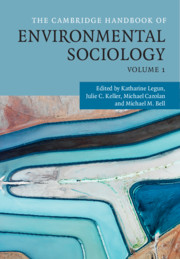Book contents
- The Cambridge Handbook of Environmental Sociology Volume 1
- The Cambridge Handbook of Environmental Sociology
- Copyright page
- Contents
- Figures
- Tables
- Contributors
- Foreword
- Introduction
- Part I Theory in Environmental Sociology
- Part II The Economy and Environmental Sociology
- Part III Culture and Environmental Sociology
- Part IV Politics, Power, State
- 17 Conflicting Environmental Imaginaries in Post-Apartheid South Africa
- 18 The Growth in International Audit Culture: Achieving Agricultural Sustainability Inside a World of Measures?
- 19 Political Ecologies of State Land Management
- 20 Green Crime and the Treadmill of Production
- 21 Governing Science and Technology: From the Linear Model to Responsible Research and Innovation
- 22 The Paradox of Public Knowledge in Environmental Sociology
- 23 Relational Resilience and the Making of Diverse Worlds
- Part V Social Justice
- Index
- References
19 - Political Ecologies of State Land Management
from Part IV - Politics, Power, State
Published online by Cambridge University Press: 05 November 2020
- The Cambridge Handbook of Environmental Sociology Volume 1
- The Cambridge Handbook of Environmental Sociology
- Copyright page
- Contents
- Figures
- Tables
- Contributors
- Foreword
- Introduction
- Part I Theory in Environmental Sociology
- Part II The Economy and Environmental Sociology
- Part III Culture and Environmental Sociology
- Part IV Politics, Power, State
- 17 Conflicting Environmental Imaginaries in Post-Apartheid South Africa
- 18 The Growth in International Audit Culture: Achieving Agricultural Sustainability Inside a World of Measures?
- 19 Political Ecologies of State Land Management
- 20 Green Crime and the Treadmill of Production
- 21 Governing Science and Technology: From the Linear Model to Responsible Research and Innovation
- 22 The Paradox of Public Knowledge in Environmental Sociology
- 23 Relational Resilience and the Making of Diverse Worlds
- Part V Social Justice
- Index
- References
Summary
Land and state efforts in management have surged onto environmental sociologists’ agenda, but our tools for examining concerns around land are limited. Practitioners of political ecology have examined just these issues in great depth, and there is much we can learn from them. Their work on how states steer development projects details how states and capitalists advance projects that displace or enlist people for productive efforts that can devastate landscapes. Their studies of land enclosure for conservation or forestry make sense of the push and pull among groups concerned with wildlife, profit, and the welfare of residents. Examining ecological restoration efforts, political ecologists identify the conditions under which these projects succeed and fail, showing how processes policymakers fail to consider often cause surprising outcomes. A further opening of the conversation between environmental sociologists and political ecologists bears great promise for cross-fertilization.
- Type
- Chapter
- Information
- The Cambridge Handbook of Environmental Sociology , pp. 315 - 330Publisher: Cambridge University PressPrint publication year: 2020



